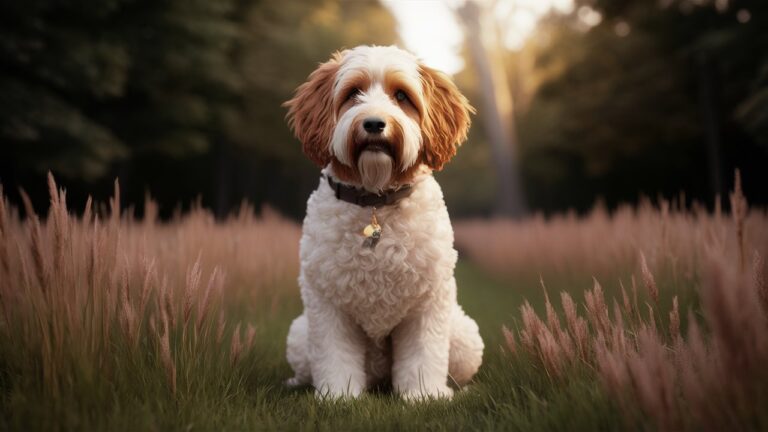The Australian Labradoodle: 100% Guide to the Perfect Family Companion
The Australian Labradoodle is a breed known for its friendly demeanor, intelligence, and hypoallergenic coat. As a blend of the Labrador Retriever, Poodle, and other breeds, this dog has quickly become a favorite among families and dog enthusiasts. In this article, we’ll explore the origins, characteristics, care requirements, and what makes the Australian Labradoodle such a special pet.
The Origins of the Australian Labradoodle

The story of the Australian Labradoodle begins in the late 1980s in Australia. A man named Wally Conron, who was working for the Royal Guide Dog Association of Australia, aimed to create a guide dog suitable for people with allergies. He started by crossing the Labrador Retriever with the Standard Poodle, hoping to combine the Labrador’s friendly and trainable nature with the Poodle’s low-shedding coat.
While the initial crossbreed, the Labradoodle, showed promise, it wasn’t until breeders introduced other breeds like the English and American Cocker Spaniels, Curly Coat Retriever, and Irish Water Spaniel that the Australian Labradoodle we know today was developed. This multi-generational breeding resulted in a more consistent and desirable breed, known for its stable temperament and hypoallergenic qualities.
Characteristics and Temperament
Australian Labradoodles are known for their friendly, social nature. They typically have a joyful and playful disposition, making them excellent companions for families, singles, and seniors alike. Here are some key characteristics of the breed:
- Size: They come in three sizes – miniature, medium, and standard. Miniatures range from 14 to 16 inches in height, mediums from 17 to 20 inches, and standards from 21 to 24 inches.
- Coat: Their coats can be curly, wavy, or straight and come in various colors, including cream, gold, red, black, and chocolate. The coat is low-shedding, making them suitable for people with allergies.
- Temperament: They are known for their intelligence, ease of training, and friendly nature. They tend to get along well with children and other pets.
One of the most memorable moments with my own Australian Labradoodle, Max, was when he helped my daughter overcome her fear of dogs. Max’s gentle and patient demeanor allowed her to feel comfortable and eventually love being around dogs. This personal experience is a testament to the breed’s exceptional temperament.
Care and Maintenance
Taking care of an Australian Labradoodle involves regular grooming, exercise, and mental stimulation. Here’s a breakdown of what to expect:
- Grooming: Despite their low-shedding coat, Australian Labradoodles require regular grooming to prevent matting and tangles. Brushing a few times a week and professional grooming every 6 to 8 weeks is recommended.
- Exercise: These dogs are active and need regular exercise to stay healthy and happy. Daily walks, playtime in the yard, or visits to the dog park are great ways to keep them engaged.
- Training: Due to their intelligence and eagerness to please, Australian Labradoodles are relatively easy to train. Positive reinforcement techniques work best. Enrolling in a puppy training class can also be beneficial.
Health and Lifespan

Australian Labradoodles are generally healthy dogs, but like all breeds, they can be prone to specific health issues. Common concerns include hip dysplasia, allergies, and eye problems. Regular veterinary check-ups and a healthy diet can help manage these risks. On average, an Australian Labradoodle has a lifespan of 12 to 15 years.
When we first brought Max home, we were diligent about his diet and exercise. We chose high-quality dog food and made sure he got plenty of playtime. This not only kept him healthy but also strengthened our bond with him.
The Perfect Family Companion
One of the reasons Australian Labradoodles make such great family pets is their adaptability. They are equally comfortable in a bustling family home as they are in a quieter, single-person household. Their friendly nature and intelligence mean they can easily adjust to various living situations and activities.
A close friend of mine, who has three young children, often shares stories about how their Labradoodle, Bella, has become an integral part of their family. Bella is not only a playmate for the kids but also a source of comfort and companionship for the entire family. Her presence has brought joy and laughter into their home, showcasing the profound impact an Australian Labradoodle can have on family life.
Finding a Reputable Breeder
If you’re considering adding an Australian Labradoodle to your family, it’s essential to find a reputable breeder. Look for breeders who prioritize health, temperament, and proper socialization of their puppies. Ask for health clearances of the puppy’s parents and visit the breeder’s facility to ensure the puppies are raised in a clean, loving environment.
Adopting from a rescue organization is another great option. Many Labradoodles are in need of loving homes, and adoption can be a rewarding experience.

Conclusion
The Australian Labradoodle is more than just a cute face; it’s a breed that brings joy, companionship, and endless love to any home. Whether you’re looking for a playmate for your kids, a companion for your daily walks, or a loyal friend to keep you company, the Australian Labradoodle is a fantastic choice. Their friendly nature, intelligence, and hypoallergenic coat make them an ideal pet for a wide range of families and individuals.
As someone who has experienced the joy of having an Australian Labradoodle, I can attest to the positive impact they have on their families. Max has become more than just a pet; he’s a beloved member of our family who enriches our lives every day. If you’re considering welcoming an Australian Labradoodle into your home, you’re in for an incredible journey filled with love, laughter, and unforgettable moments.





